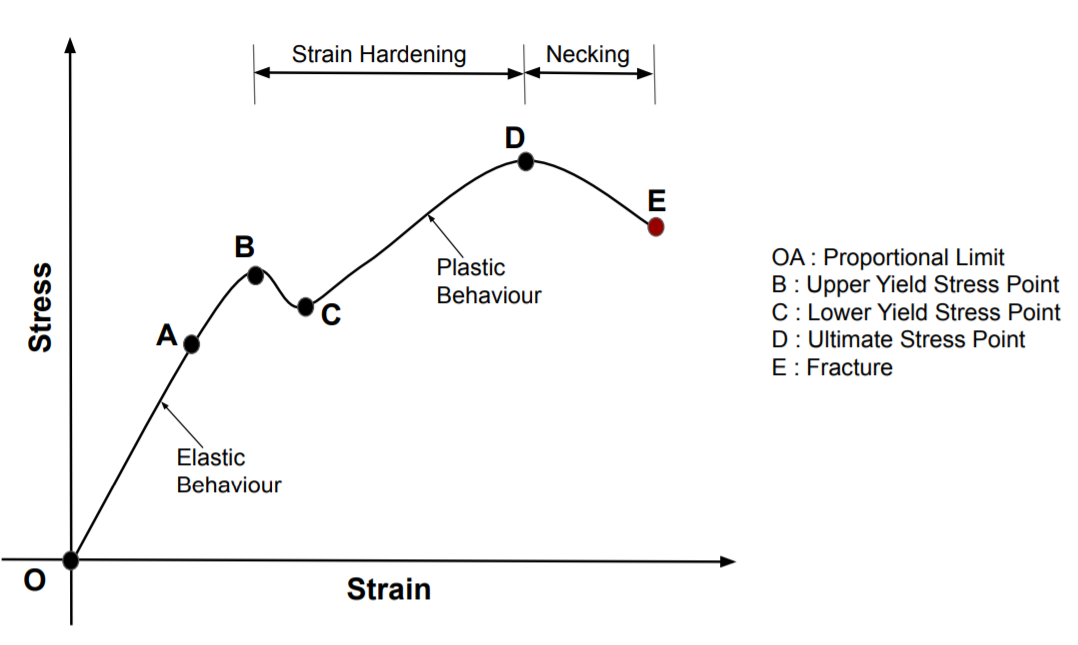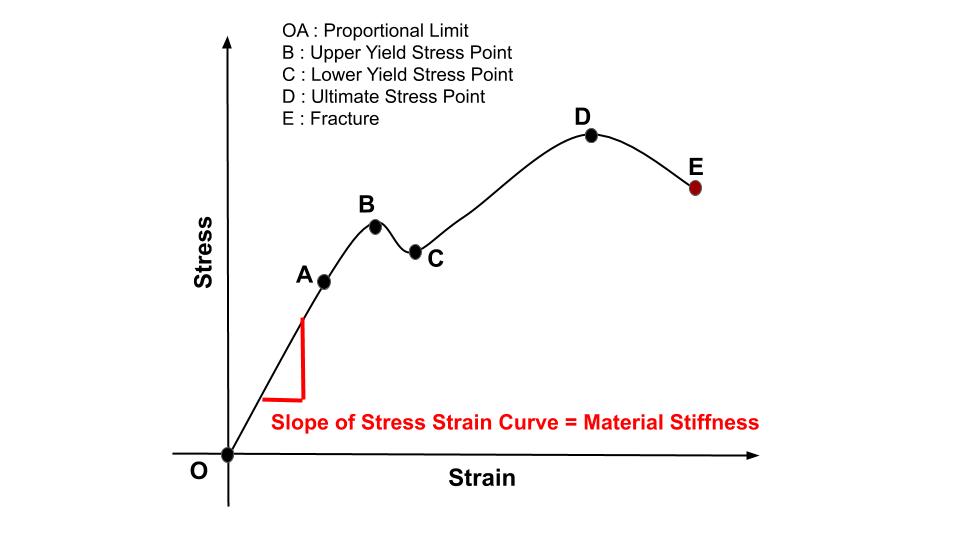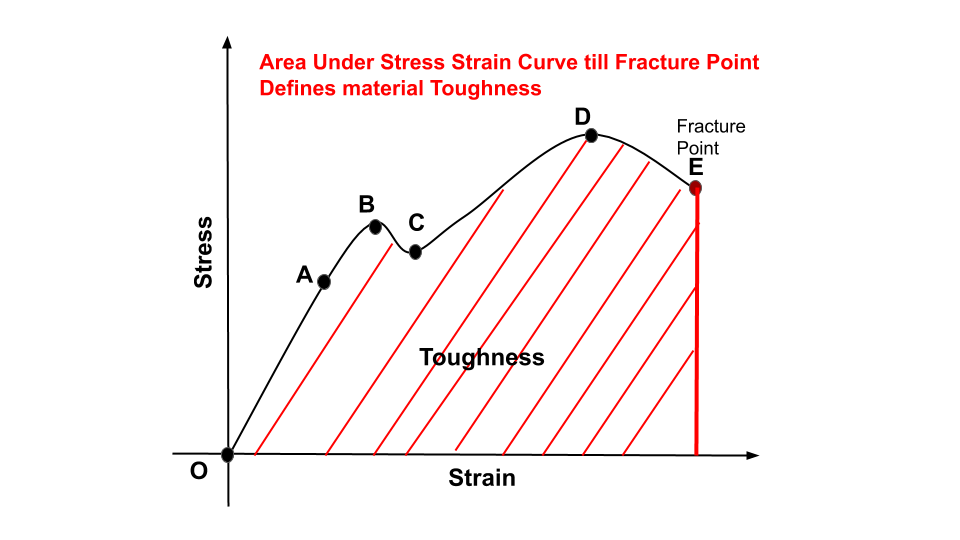Mechanical properties of material define material behavior under external load conditions such as tension, compression, and shear forces. These properties help in the selection of material during product and process design. For example, to draw wire, a material with high ductility is selected. This article covers the following mechanical properties of a material.
- Strength
- Stiffness
- Hardness
- Elasticity
- Plasticity
- Toughness
- Ductility
- Malleability
- Machinability
- Resilence
- Creep
- Fatigue
We suggest you also read this article on the Factor of Safety in mechanical engineering.
1. Strength of a Material
The Strength of a material is a property of a material that resists any change when an external force is applied. External force results in internal mechanical stresses and internal mechanical stress causes mechanical strain in the material.

As shown above, We can define the strength of a material under a stress-strain diagram of the material. During product design we use following types of material strength.
1.1) Yield Strength
Till yield point, a material exhibits elastic behavior. At this point, a material can handle maximum tensile strength before permanent deformation.
1.2) Ultimate Strength
The ultimate strength of a material is the maximum amount of external force a material can bear before failure.
1.3) Fracture Strength
Fracture strength is the maximum strength of the material on the stress-strain curve at which failure occurs.
2. Stiffness of a Material

Stiffness defines the ability of a material to resist elastic deformation when a load is applied. Modulus of elasticity in the stress-Strain curve measures the stiffness of a material.
For example, To ensure small deformation in a part, we need to select material with high stiffness or higher young modulus. Steel has higher stiffness than rubber.
3. Hardness of a Material
The hardness of a material defines the localized permanent surface deformation of a material due to an external force. The higher the hardness of a material, the high external force will be required to deform the material. Hardness looks similar to material stiffness, but it’s not correct.
The hardness of material also controls a material’s resistance to wear, scratch resistance, and machinability. We can increase a material’s hardness using various heat treatment processes.
For example, diamond is the hardest material used to cut other hard materials. Material hardness is defined using a number. We can use the following mechanical tests to determine material hardness.
- Rockwell Hardness Test.
- Vickers Hardness Test.
- Brinell Hardness Test.
- Shore Scleroscope.
4. Toughness

A material Toughness resists high impact or sudden load. Mathematically toughness is the energy absorbed per unit volume up to material fracture points.
The area under the stress-strain curve till the fracture point is known as the toughness of a material. Tough materials have applications where the part has to bear a high impact load.
5. Elasticity
Elasticity in a material helps a part in regaining its original shape when we remove the external force. In a stress-strain curve, a material behaves as an elastic material up to material yield strength.
For example, steel has more elasticity compared to rubber. The area under the stress-strain curve till the yield point is known as the elastic region of the material.
6. Plasticity
Plasticity of material helps in retaining the existing position of material even after the removal of external force. In a Stress-Strain Diagram, a material exhibits plastic behavior after yield point.
Plasticity of material has application during sheet metal bending, forging, and deep drawing operations.
7. Ductility
The Ductility of material is used to draw the material into wires by the application of tensile force. A ductile material should have good strength and plastic behavior. For example, steel, copper, and aluminum materials are ductile materials.
8. Malleability
The Malleability property of a material is used in converting a material into thin sheets. For example, We can form steel, aluminum, and copper material blocks into sheets by passing them through rolling mills.
9. Machinability
The Machinability property of a material defines how easily we can machine a material. For example, aluminum is relatively easy to machine compared to stainless steel. Therefore aluminum has good machinability compared to stainless steel.
10. Resilience of a Material
Resilience defines the ability of a material to absorb energy and resist shock. Mathematically resilience of a material is the amount of energy absorbed per unit volume within its elastic limit.
For example, spring steel has high resilience compared to aluminum. Therefore spring steels are used to manufacture springs.
11. Creep Resistance
Creep resistance in a material defines a material’s ability to deform permanently due to continuous loading. This material property has applications where the product is under stress for a prolonged time.
12. Fatigue in a Material
Fatigue in material occurs due to repetitive cyclic loading. It results in progressive or localized damages in a part or cracks. For example, Gears in a gearbox and springs in suspension systems are in continuous loading.
Commonly Asked Questions on Materials
Mechanical properties of a material are used during the selection of a material for the required application.
For example, why don’t we manufacture car roofs or doors in plastic or glass? Because glass is very fragile and it can not bear loads acting on it. We come to this conclusion by looking at the mechanical properties of glass and plastic materials.
A material mechanical property defines the material behavior under external loading conditions, whereas physical properties define the characteristics of a material. For example, conductivity, resistivity, melting point, specific heat, and density are physical properties of a material.
A material mechanical property depends on:
- Arrangement of grain structure inside the material.
- Composition of a material (such as carbon, silicon, magnesium, etc.)
Therefore we cab modify the mechanical properties of material either by changing its grain structure (Heat Treatment Process) or by modifying its chemical composition.
To sum up, the mechanical properties of a material are critical parameters in the selection of a material for a given application. The mechanical properties of a material are available in the simulation tool material library. Users can use these properties for the selection of material. We suggest you also read this article on the role of simulation in product design.
I will keep adding more information on the mechanical properties of materials. Add your suggestions, comments, or questions on the mechanical properties of materials in the comment box. We suggest you read this article on the magnetic properties of materials.

Add a Comment